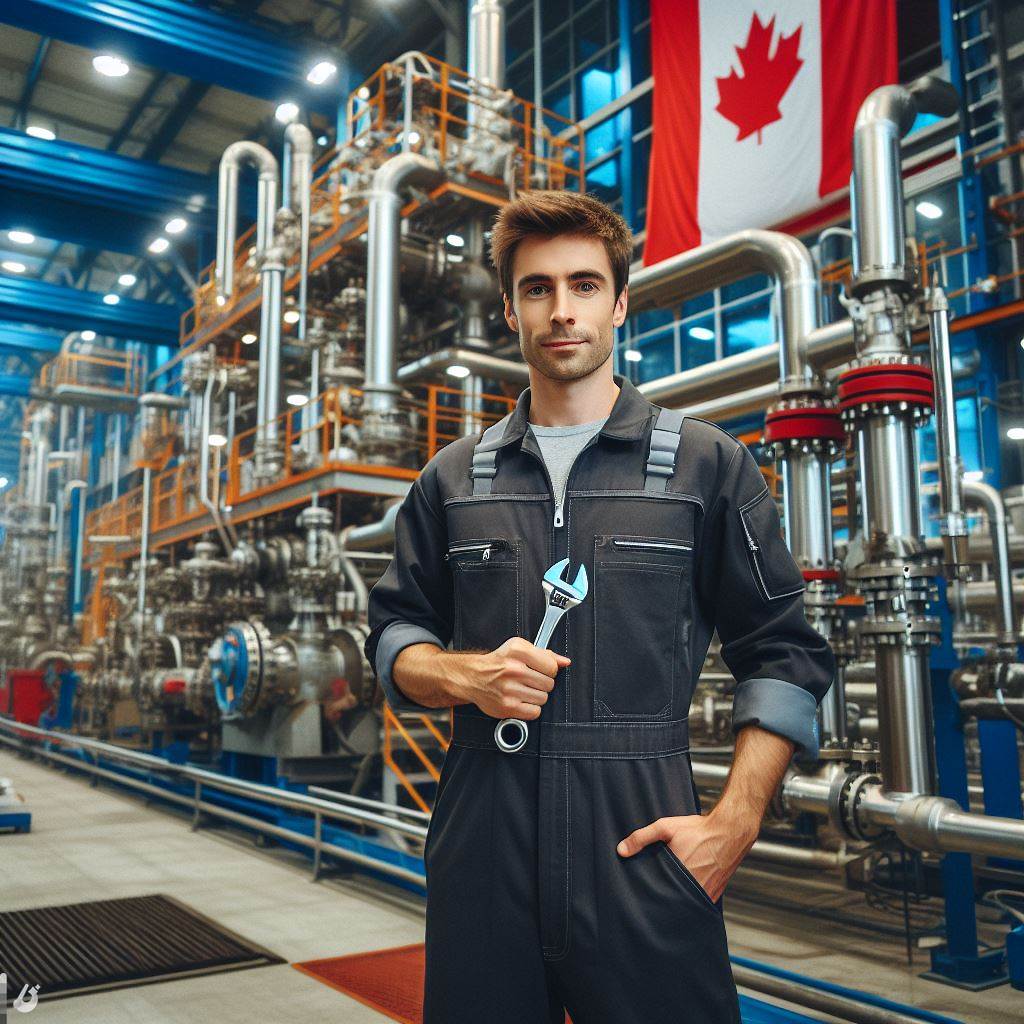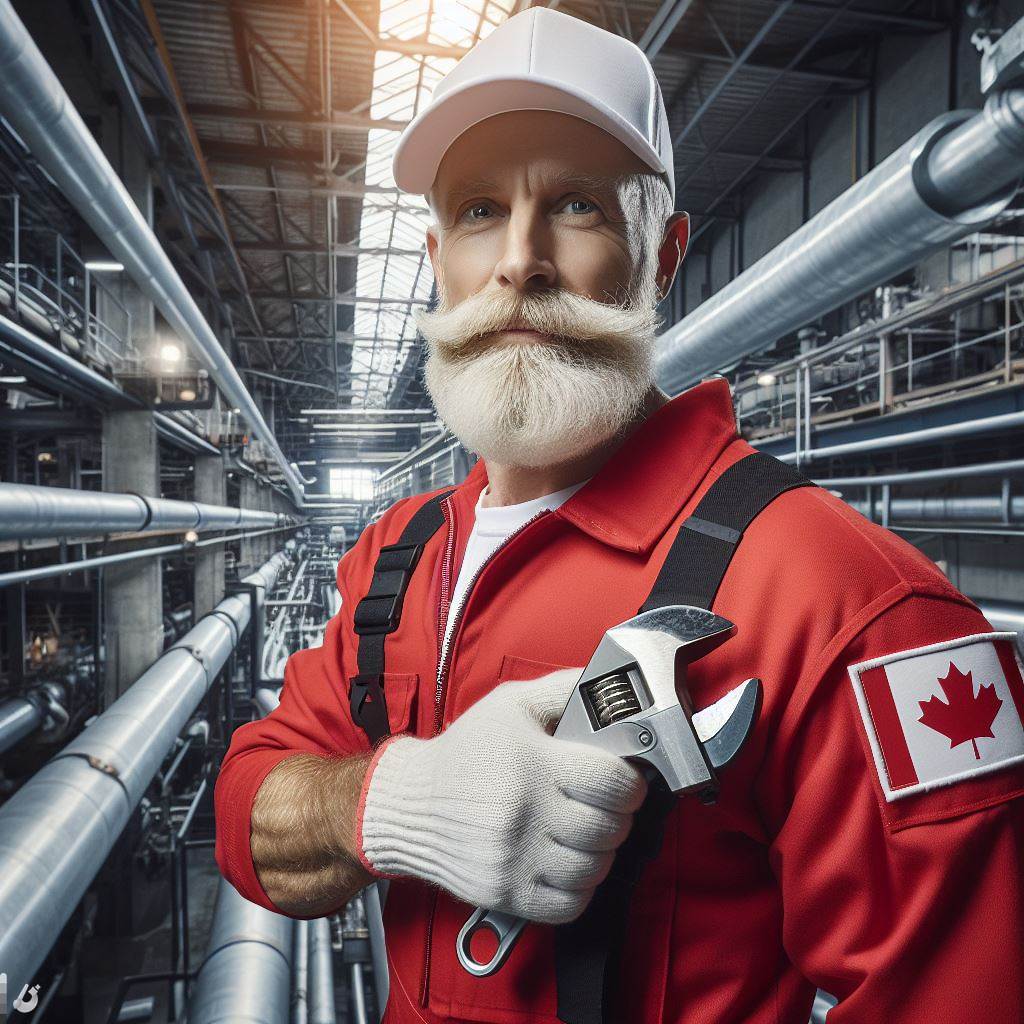Introduction
Plumbing codes in Canada play a crucial role in ensuring the safety and health of the public.
These codes govern the installation, maintenance, and repair of plumbing systems in buildings.
This blog section will provide an in-depth understanding of the importance of plumbing codes in Canada and give a brief overview of the topic.
Plumbing codes are a set of regulations that specify the standards and requirements for plumbing systems.
They cover various aspects such as pipe materials, fixture installation, drainage, and venting.
These codes are designed to prevent plumbing system failures, protect the environment, and safeguard public health.
In Canada, plumbing codes are enforced by the provincial and territorial authorities.
Each province has its own set of codes, usually based on the National Plumbing Code of Canada (NPCC).
The NPCC is a model code that provides guidelines for the installation and maintenance of plumbing systems.
The importance of plumbing codes in Canada cannot be overstated.
They ensure that plumbing systems are designed and installed correctly, minimizing the risk of leaks, water contamination, and other plumbing issues.
Compliance with these codes is mandatory for all construction and renovation projects, ensuring that buildings meet the highest standards of safety and functionality.
Plumbing codes also play a vital role in preventing the spread of diseases and protecting the environment.
Proper plumbing systems prevent the contamination of drinking water and the release of harmful substances into the environment.
In short, plumbing codes in Canada are essential for maintaining the safety, health, and well-being of the public.
They set standards for the installation and maintenance of plumbing systems and help prevent plumbing failures, water contamination, and environmental damage.
Compliance with these codes is crucial for ensuring the proper functioning of plumbing systems in buildings.
Overview of Plumbing Codes in Canada
In Canada, plumbing code are regulations and standards that govern the design, installation, and maintenance of plumbing systems in buildings.
These codes are important to ensure the safety, health, and well-being of occupants, as well as to safeguard public infrastructure and the environment.
Plumbing code cover a wide range of aspects, including water supply, drainage, venting, and fixtures, to ensure proper functioning and prevent potential hazards.
Compliance with these code is mandatory for all new construction, renovations, and plumbing installations.
Explanation of Plumbing Codes
Plumbing code provide detailed guidelines and specifications for plumbing systems to meet specific technical requirements.
They dictate the materials, methods, and practices that should be used during installation and outline the minimum standards that must be met.
Plumbing code also address issues such as backflow prevention, proper waste disposal, and accessibility to plumbing systems for maintenance purposes.
By adhering to these codes, plumbing professionals can ensure that installations are safe, reliable, and efficient.
Unlock Your Career Potential
Visualize a clear path to success with our tailored Career Consulting service. Personalized insights in just 1-3 days.
Get StartedRole of Plumbing Codes in Ensuring Safety and Quality
Plumbing code play a crucial role in maintaining the safety and quality of plumbing systems across Canada.
They help prevent potential health hazards, such as contaminated water supply or sanitary sewer backups, by establishing guidelines for proper installation and maintenance.
Plumbing code also contribute to the longevity of plumbing systems and reduce the risk of costly repairs or replacements due to substandard work.
Furthermore, compliance with plumbing code ensures that buildings meet the necessary standards for insurance coverage and regulatory inspections.
Authorities Responsible for Establishing and Enforcing Codes
In Canada, plumbing code are established and enforced by various authorities at different levels.
The National Plumbing Code of Canada (NPCC) is developed by the Canadian Commission on Building and Fire Codes (CCBFC), a branch of the National Research Council.
This code forms the basis for provincial and territorial plumbing code, which may incorporate additional requirements specific to local conditions.
Provincial and territorial municipalities are responsible for enforcing plumbing code through their building departments and regulatory agencies.
Inspectors are appointed to review plans, issue permits, and conduct on-site inspections to ensure compliance with the codes.
Non-compliance with plumbing codes may result in penalties, fines, or the requirement to rectify the issues before buildings can be occupied.
Plumbing codes in Canada are essential for maintaining safety, quality, and efficiency in plumbing systems.
By adhering to these codes, plumbers, builders, and homeowners can contribute to the overall well-being of occupants and the longevity of buildings.
It is important to stay updated on the latest plumbing code to ensure compliance and to engage qualified professionals for plumbing installations and renovations.
Read: Essential Tools Every Canadian Plumber Needs
History and Development of Plumbing Codes in Canada
Plumbing code in Canada have evolved significantly over time, adapting to industry standards and technological advancements.
The introduction of national and provincial code has played a crucial role in ensuring the safety and efficiency of plumbing systems across the country.
Here are some key points to understand the history and development of plumbing code in Canada:
Evolution of Plumbing Codes over Time
Plumbing codes in Canada have a long history that dates back to the early 1900s.
Initially, these codes were developed on a regional basis, with each province having its own set of regulations.
However, as plumbing practices became more standardized, the need for national code emerged.
Influence of Industry Standards and Technological Advancements
The evolution of plumbing code has been driven by industry standards and technological advancements.
New materials, techniques, and equipment have constantly emerged, necessitating updates to the existing codes to accommodate these changes.
This ensures that plumbing systems remain safe and efficient.
Introduction of National or Provincial Codes
To create consistency and improve safety, Canada has seen the introduction of both national and provincial plumbing codes.
The National Plumbing Code of Canada (NPCC) sets minimum standards for plumbing installations nationwide, while provincial code complement these standards with specific requirements.
National Plumbing Code of Canada (NPC)
The NPC is an essential document that provides guidelines for plumbing installations in various types of buildings.
It covers topics such as water supply, drainage systems, venting, backflow prevention, and more.
The NPC is regularly updated to incorporate new technologies and best practices.
Provincial Codes
In addition to the NPC, each province in Canada has its own plumbing code that applies within its jurisdiction.
These codes may include additional requirements or modifications to suit local conditions or specific regional needs.
Plumbing professionals must familiarize themselves with both the national and provincial code to ensure compliance.
Compliance and Enforcement
Plumbing code are not mere suggestions; they are enforceable regulations that help protect public health and safety.
Compliance with these codes is mandatory, and enforcement agencies play a vital role in ensuring adherence.
Regular inspections are conducted to verify that plumbing installations meet the required standards.
Benefits of Plumbing Codes
Having well-established plumbing code brings several benefits.
They promote uniformity in plumbing practices, ensuring consistency and quality across the country.
Compliance with code helps prevent water contamination, sewage backups, and other plumbing-related issues.
It also enhances the longevity and efficiency of plumbing systems, ultimately saving costs for both homeowners and businesses.
The history and development of plumbing codes in Canada reflect the industry’s commitment to continuous improvement and the highest standards of safety and efficiency.
With the evolution of plumbing practices, the introduction of national and provincial code has become indispensable.
Compliance with these code is crucial for plumbers, homeowners, and enforcement agencies to safeguard public health and ensure the longevity of plumbing systems.
Read: Canadian Plumbers’ Earnings: Expectations vs Reality
Key Components of Plumbing Codes in Canada
Plumbing code in Canada play a crucial role in ensuring the safety and functionality of plumbing systems.
These code consist of several key components that guide the design, installation, and maintenance of plumbing systems across the country.
Understanding these components is essential for plumbers, homeowners, and contractors alike.
Plumbing System Design and Installation Guidelines
- Code provide guidelines for designing and installing plumbing systems according to industry standards.
- They specify the minimum requirements for pipe diameter, slope, and layout to ensure proper water flow and drainage.
- Guidelines focus on preventing cross-connections, backflow, and contamination of the potable water supply.
Material and Equipment Requirements
- Plumbing code outline the acceptable materials and equipment that can be used for plumbing installations.
- They ensure that only certified and approved products are used, guaranteeing quality and safety.
- Codes specify standards for pipes, fittings, valves, and other components to prevent leaks, corrosion, and failures.
Ventilation and Drainage Regulations
- Plumbing code include regulations for proper ventilation and drainage of plumbing systems.
- They establish requirements for vent pipes to prevent the buildup of harmful gases like methane.
- Code also dictate the correct methods for connecting fixtures to drainage systems, maintaining correct air pressure.
Inspections and Approvals Process
- Plumbing codes mandate that plumbing systems undergo inspections at various stages of construction or renovation.
- Inspectors ensure compliance with codes, verify proper installation, and identify any potential issues.
- Plumbing work must be approved by the relevant authority before being covered or concealed.
In essence, plumbing code in Canada consist of crucial components that regulate plumbing system design, installation, materials, ventilation, drainage, and inspections.
Following these code is essential for safe and effective plumbing operations.
Read: Career Paths in Plumbing: Opportunities in Canada
Compliance and Enforcement of Plumbing Codes
Responsibilities of Homeowners, Plumbers, and Contractors
- Homeowners must ensure that plumbing work complies with the local plumbing code.
- Plumbers and contractors are responsible for installing and maintaining plumbing systems according to code requirements.
- They should have a thorough understanding of the codes and stay updated with any changes.
Consequences of Non-Compliance
- Non-compliance with plumbing code can lead to safety hazards and potential property damage.
- Homeowners may face fines, penalties, or legal consequences for not following the plumbing code.
- Insurance claims related to plumbing issues may be denied if the work was not done in compliance with code.
Inspections and Permits
- Building inspectors conduct inspections at various stages of plumbing installation to ensure compliance.
- Inspectors check for proper materials, connections, and adherence to code standards.
- Permits are required before starting any plumbing work and serve as proof of compliance with the code.
Collaboration with Building Inspectors and Authorities
- Plumbers, contractors, and homeowners need to collaborate with building inspectors to ensure code compliance.
- Inspectors provide guidance, answer questions, and help resolve any code-related issues.
- Authorities rely on building inspectors’ reports to ensure that all plumbing work meets the necessary standards.
Complying with plumbing code is crucial to safeguard the health and well-being of residents.
It is essential for homeowners, plumbers, and contractors to understand their responsibilities and ensure they stay up to date with the latest plumbing code.
Non-compliance can have severe consequences, including safety hazards and legal repercussions.
Therefore, it is vital to obtain the necessary permits and undergo inspections to ensure that all work meets the required standards.
Collaborating with building inspectors and authorities provides guidance and ensures a successful and compliant plumbing system.
Read: Plumber Licenses in Canada: A Detailed Guide

Challenges and Controversies Surrounding Plumbing Codes
Plumbing codes in Canada play a crucial role in ensuring the safety and functionality of plumbing systems in buildings.
However, they are not without their fair share of challenges and controversies.
Here are some of the key issues:
Balancing safety requirements with affordability
- The main challenge for plumbing codes is finding the right balance between safety requirements and affordability.
- Stringent regulations can increase the cost of plumbing installations and repairs, impacting homeowners and businesses financially.
- On the other hand, relaxing requirements for cost-saving purposes can compromise the safety and performance of plumbing systems.
- There is an ongoing debate about whether the current codes strike the right balance or need further adjustments.
Adoption of new technologies and innovation
- Plumbing codes need to keep up with the latest technological advancements and innovative plumbing solutions.
- New materials, products, and techniques are constantly emerging, challenging existing codes that may not address them adequately.
- It is crucial for codes to incorporate provisions for these advancements while ensuring they meet safety and quality standards.
- This requires ongoing research, collaboration with industry professionals, and regular updates to the codes.
Debate over uniform codes or regional variations
- Another source of controversy is whether plumbing codes should be uniform across the entire country or allow for regional variations.
- Having uniform codes ensures consistency in safety standards and simplifies compliance for professionals working in multiple provinces.
- However, regional variations may be necessary to accommodate unique climatic conditions, geological factors, or local building practices.
- The challenge lies in finding a balance between uniformity and flexibility to cater to diverse needs without compromising safety.
In general, plumbing codes in Canada face various challenges and controversies, including the delicate balance between safety and affordability, the integration of new technologies, and the debate over uniformity versus regional variations.
It is essential for industry stakeholders, regulators, and professionals to continually evaluate and update these codes to ensure the safety, efficiency, and adaptability of plumbing systems in the ever-evolving construction landscape.
Recent Updates and Future of Plumbing Codes in Canada
Plumbing codes in Canada are constantly evolving to keep up with advancements in technology, environmental sustainability, and safety standards.
Recent revisions and changes in plumbing codes have had a significant impact on the industry.
Here are some key updates and anticipated developments:
Recent Revisions and Changes in Plumbing Codes
- Introduction of WaterSense Standards: Plumbing codes have integrated WaterSense standards, promoting water efficiency in plumbing fixtures.
- Expansion of Cross-Connection Control: There have been updates to cross-connection control requirements to safeguard potable water supply.
- Improved Backflow Prevention: Plumbing codes now include stricter regulations for backflow prevention devices to prevent contamination of water supply.
- Enhanced Pipe Sizing Methods: Recent revisions have introduced more accurate pipe sizing methods for better system performance and efficiency.
- Inclusion of New Technology: Codes now address the installation and use of new plumbing technologies, such as smart fixtures and water meters.
Impact of Environmental Sustainability Considerations
Plumbing codes in Canada are increasingly incorporating environmental sustainability considerations into their regulations.
Here are some of the notable impacts:
- Promoting Water Conservation: Plumbing codes encourage the use of water-saving fixtures to reduce water consumption and promote sustainability.
- Standardizing Energy-Efficient Systems: Codes now emphasize the installation of energy-efficient heating systems, such as heat pumps and solar water heaters.
- Reducing Stormwater Runoff: Updated codes require the implementation of stormwater management strategies, such as rainwater harvesting and permeable pavement.
- Addressing Greywater Systems: Plumbing codes are evolving to include guidelines for the safe and efficient use of greywater systems, encouraging recycling and reuse.
- Supporting Green Building Initiatives: Codes align with green building certifications, such as LEED, by promoting sustainable plumbing practices.
Anticipated Developments and Trends
The future of plumbing codes in Canada is expected to witness several advancements and trends.
Here are some anticipated developments:
- Integration of Smart Technology: Plumbing codes will likely adapt to accommodate smart technology, allowing for improved monitoring and control of plumbing systems.
- Expansion of Water Treatment Regulations: Codes may introduce stricter regulations for water treatment systems to ensure safe and quality water supply.
- Implementation of Low-Impact Development Techniques: Future revisions will likely encourage the use of low-impact development techniques to minimize environmental footprint.
- Focus on Aging Infrastructure: Plumbing codes will address the challenges of aging infrastructure, emphasizing the need for regular maintenance and upgrades.
- Embracing Sustainable Materials: Codes may require the use of sustainable materials in plumbing systems, promoting environmental stewardship.
In a nutshell, plumbing codes in Canada are continuously evolving to address the changing needs and challenges of the industry.
Recent updates and future developments aim to promote water conservation, energy efficiency, and environmental sustainability.
Plumbers and industry professionals must stay informed about these codes to ensure compliance and deliver safe and sustainable plumbing solutions.
Delve into the Subject: Essential Tools for Every Construction Site
See Related Content: Safety Protocols for Electricians in Canada
Conclusion
Plumbing codes play a crucial role in ensuring the safety and functionality of plumbing systems in Canada.
These regulations are in place to protect public health and the environment.
It is vital for homeowners, plumbers, and contractors to stay informed about the latest codes and regulations.
By doing so, they can ensure that their plumbing systems meet the required standards and prevent potential issues or accidents.
Failure to comply with these codes can result in legal consequences, costly repairs, and health hazards.
Therefore, it is essential to always stay updated with the plumbing codes in Canada and seek professional help when needed.
Remember, knowledge is power when it comes to plumbing regulations, and staying informed will save you time, money, and potential headaches in the long run.
So, embrace the importance of plumbing codes and stay informed to ensure the safety and functionality of your plumbing system.




